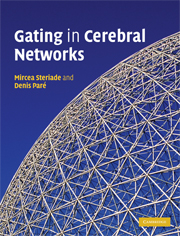Book contents
- Frontmatter
- Contents
- Preface
- Acknowledgements
- Chapter 1 Morphology and electroresponsive properties of thalamic neurons
- Chapter 2 Morphology and electroresponsive properties of neocortical cells
- Chapter 3 The amygdala
- Chapter 4 Rhinal and medial prefrontal cortices
- Chapter 5 Neuromodulation and state-dependent activities in forebrain neuronal circuits
- Chapter 6 Gating of signals in slow-wave sleep
- Chapter 7 Neuronal processes and cognitive functions in brain-active states of waking and REM sleep
- Chapter 8 Comparison of state-dependent activity patterns in the thalamocortical, hippocampal and amygdalocortical systems
- Chapter 9 Neuronal substrates of some mental disorders
- References
- Index
- Plate section
Chapter 8 - Comparison of state-dependent activity patterns in the thalamocortical, hippocampal and amygdalocortical systems
Published online by Cambridge University Press: 18 August 2009
- Frontmatter
- Contents
- Preface
- Acknowledgements
- Chapter 1 Morphology and electroresponsive properties of thalamic neurons
- Chapter 2 Morphology and electroresponsive properties of neocortical cells
- Chapter 3 The amygdala
- Chapter 4 Rhinal and medial prefrontal cortices
- Chapter 5 Neuromodulation and state-dependent activities in forebrain neuronal circuits
- Chapter 6 Gating of signals in slow-wave sleep
- Chapter 7 Neuronal processes and cognitive functions in brain-active states of waking and REM sleep
- Chapter 8 Comparison of state-dependent activity patterns in the thalamocortical, hippocampal and amygdalocortical systems
- Chapter 9 Neuronal substrates of some mental disorders
- References
- Index
- Plate section
Summary
The significance of neuronal oscillations in the amygdala and related cortices
Even when deprived of sensory stimulation, neurons hum continuously. That is, their membrane potential fluctuates constantly and the depolarizing phase of these oscillations sometimes gives rise to action potentials. Interestingly, this spontaneous activity is not random. Correlated neuronal events, occurring in a pulsatile or oscillatory manner, can be measured in the extracellular space as currents. These events result from non-linear interactions between the intrinsic membrane properties of neurons and the particular properties of the synaptic network of which they are a part (Llinás, 1988). Oscillations in various frequency ranges are observed in different brain regions; these rhythms vary depending on the behavioural state (Buzsáki et al., 1983; Steriade, 1997a).
The relevance of oscillations to brain function stems from the fact that neuronal events underlying cognition are embedded in these endogenous rhythms. Stated otherwise, one cannot disentangle oscillations from coding in large neuronal ensembles. Moreover, during sleep, when the brain is largely disconnected from the outside world, neurons generate a variety of oscillations and synchronized population bursts that are thought to play a critical role in memory consolidation (see Section 6.3). Finally, because related parts of the brain tend to display similar oscillations, the analysis of spontaneous oscillatory activity can reveal functional kinship among brain structures.
This chapter compares the neuronal oscillations displayed by the amygdala and related cortices.
- Type
- Chapter
- Information
- Gating in Cerebral Networks , pp. 218 - 227Publisher: Cambridge University PressPrint publication year: 2007



